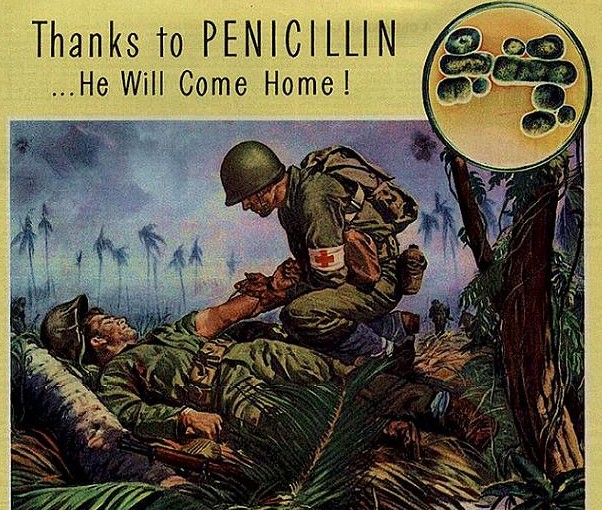Looking for the most current news, updates, and articles relating to microbiology, go to The American Society for Microbiology educational website Microbe World.
|
|
|
|
|

|
 Print this Page Print this Page
To search the entire book, enter a term or phrase in the form below
Bacterial Resistance to Antibiotics (page 1)
(This chapter has 4 pages)
© Kenneth Todar, PhD
Introduction
In the past 60 years, antibiotics have been critical in the fight
against infectious disease caused by bacteria and other microbes.
Antimicrobial chemotherapy has been a leading cause for the dramatic
rise of average life expectancy in
the Twentieth Century. However, disease-causing microbes that have
become resistant to antibiotic drug
therapy are an increasing public health problem. Wound infections,
gonorrhea, tuberculosis, pneumonia, septicemia and childhood ear
infections are
just a few of the
diseases that have become hard to treat with antibiotics. One part of
the
problem is that bacteria and other
microbes that cause infections are remarkably resilient and have
developed several ways to resist antibiotics and other antimicrobial
drugs. Another part of the problem is due to increasing
use, and misuse, of existing antibiotics in human and veterinary
medicine and in agriculture.
In 1998, in the
United States, 80 million prescriptions of antibiotics for human use
were filled. This equals 12,500 tons in one year. Animal and
agricultural uses of antibiotics are added to human use. Agricultural
practices account for over 60% of antibiotic usage in the U.S., so this
adds an additional 18,000 tons per year to the antibiotic burden in
the environment.
Nowadays, about 70 percent of the bacteria that cause infections in
hospitals are resistant to at least one of the drugs most commonly used
for
treatment. Some organisms are resistant to all approved antibiotics and
can only be treated
with experimental and potentially toxic drugs. An alarming increase in
resistance
of bacteria that cause community acquired infections has also been
documented,
especially in the staphylococci and pneumococci (Streptococcus
pneumoniae),
which are prevalent causes of disease and mortality. In a recent study,
25% of bacterial pneumonia cases were
shown to be resistant to penicillin, and an additional 25% of cases
were
resistant to more than one antibiotic.
Microbial development of resistance, as well as economic incentives,
has
resulted in research and development in the search for new
antibiotics in order to maintain a pool of effective drugs at all
times. While the development of resistant strains is inevitable, the
slack ways that we administer and use antibiotics has greatly
exacerbated the process.
Unless antibiotic resistance problems are detected as they emerge, and
actions are taken immediately to contain them, society could be faced
with previously treatable diseases that have become again untreatable,
as in the days before antibiotics were developed.
History of antibiotics and emergence of
antibiotic resistance
The first antibiotic, penicillin, was discovered in 1929 by Sir
Alexander Fleming, who observed inhibition of staphylococci on an agar
plate contaminated by a Penicillium mold. Fleming was
searching for potential antibacterial compounds.
He noticed that a patch of the mold Penicillium notatum had
grown on a plate containing the bacterium Staphylococcus and
that around the mold there was a zone where no Staphylococcus
could grow. After more research, he was able to show that culture broth
of the mold prevented growth of the Staphylococcus
even when diluted up
to 800 times. He named the active substance penicillin but was unable
to isolate it.

In the center of the plate is a
colony of Penicillium notatum, a mold that produces penicillin.
After appearance of the mold colony, the plate was overlaid with a
bacterial culture of Micrococcus
luteus which forms a yellow "lawn" of
growth. A zone of inhibition of bacterial growth surrounds the fungal
colony where penicillin has diffused into the medium.
http://helios.bto.ed.ac.uk/bto/microbes/penicill.htm#Top
Several years
later, in 1939, Ernst Chain and
Howard Florey developed a way to isolate penicillin and used it to
treat bacterial infections during the Second World War. The new drug
came into clinical usage in 1946 and made a huge impact on public
health. For these discoveries Fleming, Chain and Florey were awarded
the Nobel prize in 1945. Their discovery
and development revolutionized modern medicine and paved the way for
the development of many more natural antibiotics.

While Fleming was
working on penicillin, Gerhard Domagk, a German doctor, announced the
discovery of a synthetic molecule with antibacterial properties. He
named the compound Prontosil, and it became the first of a long series
of
synthetic antibiotics called sulfonamides or sulfa drugs. Prontosil was
introduced to clinical use in the 1930s and was used to combat urinary
tract infections, pneumonia and other conditions. While sulfa drugs in
many cases are not as effective as natural antibiotics, they are now in
widespread use for the treatment of many conditions. Gerhard Domagk was
awarded the Nobel prize in 1939 for his discovery of Prontosil.
In 1946, penicillin became
generally
available for treatment of bacterial infections, especially those
caused
by staphylococci and streptococci. Initially, the antibiotic was
effective against all sorts of infections caused by these two
Gram-positive bacteria. Penicillin had unbelievable ability to kill
these bacterial pathogens without harming the host that harbored them.
It is important to note that a significant fraction of all human
infections are caused by these two bacteria (i.e., strep
throat, pneumonia, scarlet fever, septicemia, skin infections, wound
infections,
etc.).
In the late 1940s and early 1950s, new antibiotics were introduced,
including streptomycin, chloramphenicol and tetracycline, and the age
of antibiotic chemotherapy came into full being. These antibiotics were
effective against the full array of bacterial pathogens including
Gram-positive and Gram-negative bacteria, intracellular parasites, and
the tuberculosis bacillus. Synthetic antimicrobial agents such as the
"sulfa drugs" (sulfonamides) and anti-tuberculosis
drugs, such as para aminosalicylic acid (PAS) and isoniazid (INH),
were
also brought
into wider usage.
chapter continued
Next Page
|
|